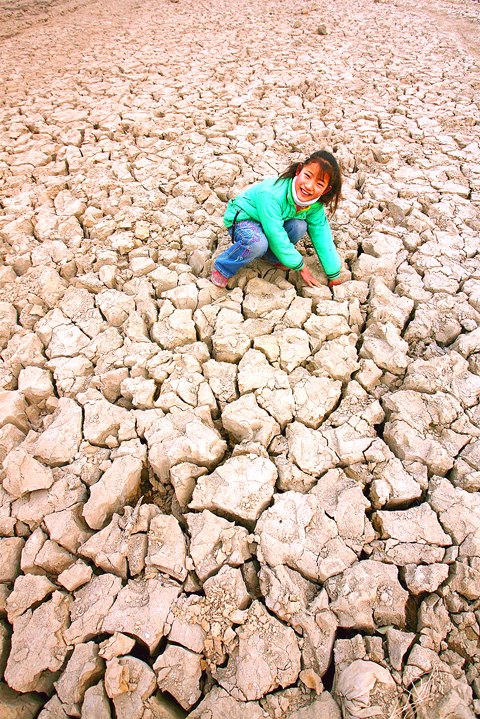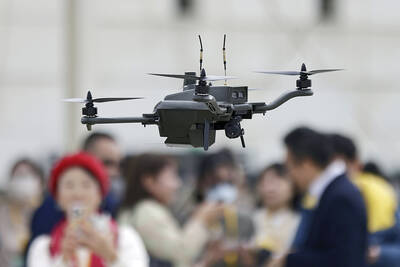China was struggling yesterday to get water to millions of people and save swathes of its wheat harvest, after raising its drought emergency status to the highest level for the first time.
The decision to go to emergency level one was taken on Thursday at a meeting of the State Flood Control and Drought Relief Headquarters, Xinhua news agency reported.
Eight provinces and municipalities are affected, stretching in a broad belt from Gansu on the Mongolian border in the northwest to Shandong on the Yellow Sea in the east.

PHOTO: AFP
About 43 percent of the country’s winter wheat supplies are at risk, as some areas have seen no rain for 100 days or more, state media said.
The increased alert level was made official at the same time as the central government sent out specialists to the major drought-hit regions to help residents with relief supplies and technical aid, the China Daily said.
About 4.3 million people and 2.1 million head of livestock are short of water, the relief headquarters said in a statement, as parts of the nation experience their worst drought since the early 1950s.
Chinese Vice Premier Hui Liangyu (�?}) held a state conference on Thursday to coordinate and strengthen efforts to help the affected regions, calling for quick financial and material support, the China Daily reported.
Hui also urged local governments to speed up the construction of irrigation systems for crops, the paper said, although it was unclear if this could be done fast enough to help alleviate the current crisis.
The dry spell highlights one of China’s main long-term worries, as water resources are becoming rapidly depleted due to fast economic growth.
Beijing, is particularly badly hit, with experts warning the city, home to 17 million people, will soon have reached the limit beyond which there will not be enough water to go around.
Last September authorities were forced into a six-month emergency diversion scheme that is seeing water being pumped from neighboring Hebei Province to Beijing.
The water flows along a 305km canal stretching from the Hebei capital of Shijiazhuang to Beijing and fed by three major reservoirs.
The canal is part of China’s ambitious North-South Water Diversion Project, a multi-billion dollar scheme to bring water from the nation’s longest river, the Yangtze, to the parched north.
Shaanxi Province, among the areas hardest hit by the drought, will try to induce rain or snowfall to relieve parched soil.
The province will time the effort to coincide with when a weak cold front from the Xinjiang Autonomous Region meets a warm stream from the southwest, the China Meteorological Administration said on its Web site yesterday. Local agencies will use rockets, cannon and aircraft to fire chemicals into the sky to seed the clouds and increase rainfall.
About 210 rockets and 400 cannons are in place, the report said. Airplanes will be deployed for man-made rains from late this month to next month, it said.

FORCED LABOR: A US court listed three Taiwanese and nine firms based in Taiwan in its indictment, with eight of the companies registered at the same address Nine companies registered in Taiwan, as well as three Taiwanese, on Tuesday were named by the US Department of the Treasury’s Office of Foreign Assets Control (OFAC) as Specially Designated Nationals (SDNs) as a result of a US federal court indictment. The indictment unsealed at the federal court in Brooklyn, New York, said that Chen Zhi (陳志), a dual Cambodian-British national, is being indicted for fraud conspiracy, money laundering and overseeing Prince Holding Group’s forced-labor scam camps in Cambodia. At its peak, the company allegedly made US$30 million per day, court documents showed. The US government has seized Chen’s noncustodial wallet, which contains

SUPPLY CHAIN: Taiwan’s advantages in the drone industry include rapid production capacity that is independent of Chinese-made parts, the economic ministry said The Executive Yuan yesterday approved plans to invest NT$44.2 billion (US$1.44 billion) into domestic production of uncrewed aerial vehicles over the next six years, bringing Taiwan’s output value to more than NT$40 billion by 2030 and making the nation Asia’s democratic hub for the drone supply chain. The proposed budget has NT$33.8 billion in new allocations and NT$10.43 billion in existing funds, the Ministry of Economic Affairs said. Under the new development program, the public sector would purchase nearly 100,000 drones, of which 50,898 would be for civil and government use, while 48,750 would be for national defense, it said. The Ministry of

SENATE RECOMMENDATION: The National Defense Authorization Act encourages the US secretary of defense to invite Taiwan’s navy to participate in the exercises in Hawaii The US Senate on Thursday last week passed the National Defense Authorization Act (NDAA) for Fiscal Year 2026, which strongly encourages the US secretary of defense to invite Taiwan’s naval forces to participate in the Rim of the Pacific (RIMPAC) exercise, as well as allocating military aid of US$1 billion for Taiwan. The bill, which authorizes appropriations for the military activities of the US Department of Defense, military construction and other purposes, passed with 77 votes in support and 20 against. While the NDAA authorizes about US$925 billion of defense spending, the Central News Agency yesterday reported that an aide of US

UNITED: The other candidates congratulated Cheng on her win, saying they hoped the new chair could bring the party to victory in the elections next year and in 2028 Former Chinese Nationalist Party (KMT) lawmaker Cheng Li-wun (鄭麗文) yesterday won the party’s chair election with 65,122 votes, or 50.15 percent of the votes. It was the first time Cheng, 55, ran for the top KMT post, and she is the second woman to hold the post of chair, following Hung Hsiu-chu (洪秀柱), who served from 2016 to 2017. Cheng is to succeed incumbent Eric Chu (朱立倫) on Nov. 1 for a four-year term. Cheng said she has spoken with the other five candidates and pledged to maintain party unity, adding that the party would aim to win the elections next year and